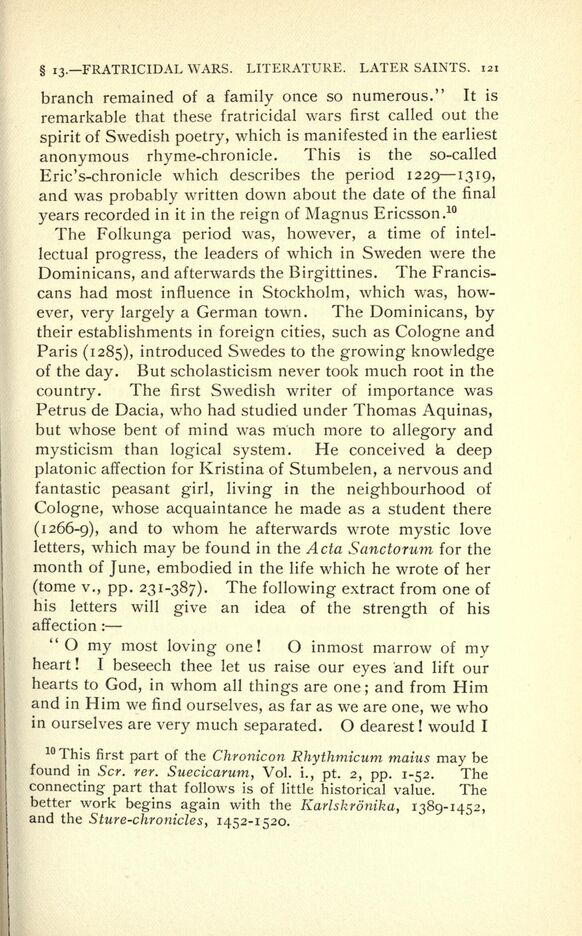
Full resolution (JPEG) - On this page / på denna sida - III. The Romanized Church under the Sverkers, Erics and Folkungar (1130—1389 A.D.)

<< prev. page << föreg. sida << >> nästa sida >> next page >>
Below is the raw OCR text
from the above scanned image.
Do you see an error? Proofread the page now!
Här nedan syns maskintolkade texten från faksimilbilden ovan.
Ser du något fel? Korrekturläs sidan nu!
This page has never been proofread. / Denna sida har aldrig korrekturlästs.
I3- FRATRICIDAL WARS. LITERATURE. LATER SAINTS. 121
branch remained of a family once so numerous." It is
remarkable that these fratricidal wars first called out the
spirit of Swedish poetry, which is manifested in the earliest
anonymous rhyme-chronicle. This is the so-called
Eric s-chronicle wr
hich describes the period 1229 1319,
and was probably written down about the date of the final
years recorded in it in the reign of Magnus Ericsson.10
The Folkunga period was, however, a time of intel
lectual progress, the leaders of which in Sweden were the
Dominicans, and afterwards the Birgittines. The Francis
cans had most influence in Stockholm, which was, how
ever, very largely a German town. The Dominicans, by
their establishments in foreign cities, such as Cologne and
Paris (1285), introduced Swedes to the growing knowledge
of the day. But scholasticism never took much root in the
country. The first Swedish writer of importance was
Petrus de Dacia, who had studied under Thomas Aquinas,
but whose bent of mind was much more to allegory and
mysticism than logical system. He conceived la
deep
platonic affection for Kristina of Stumbelen, a nervous and
fantastic peasant girl, living in the neighbourhood of
Cologne, whose acquaintance he made as a student there
(1266-9), and to whom he afterwards wrote mystic love
letters, which may be found in the A eta Sanctorum for the
month of June, embodied in the life which he wrote of her
(tome v., pp. 231-387). The following extract from one of
his letters will give an idea of the strength of his
affection :
"
O my most loving one! O inmost marrow of my
heart ! I beseech thee let us raise our eyes and lift our
hearts to God, in whom all things are one ;
and from Him
and in Him we find ourselves, as far as we are one, we who
in ourselves are very much separated. O dearest ! would I
L0
This first part of the Chronicon Rhythmicum mains may be
found in Scr. rer. Suecicarum y
Vol. i., pt. 2, pp. 1-52. The
connecting part that follows is of little historical value. The
better work begins again with the Karlskronika, 1389-1452,
and the Sture-chronicles, 1452-1520.
<< prev. page << föreg. sida << >> nästa sida >> next page >>